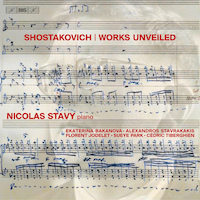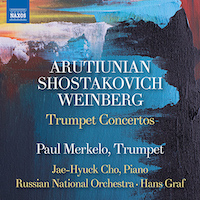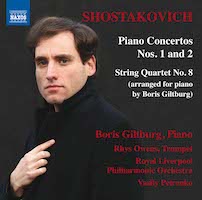(Dis)Arrangements 16: Shostakovich
|
Grant Chu Covell [August 2023.]
“Works Unveiled.” Dmitri SHOSTAKOVICH: Symphony No. 14, Op. 135 (1969; arr. SHOSTAKOVICH)1; Sonata for violin and piano (unfinished, 1945)2; Four Pieces: Funeral March in Memory of Victims of the Revolution, Toska (“Nostalgia”), In the Forest and Bagatelle (1917?-19)3. Gustav MAHLER: Adagio from Symphony No. 10 (1910-11; arr. SHOSTAKOVICH, ca 1925-29)4. Ekaterina Bakanova1 (sop), Alexandros Stavrakakis1 (bass), Florent Jodelet1 (perc), Sueye Park2 (vln), Nicolas Stavy1,2,3,4, Cédric Tiberghien4 (pno). BIS BIS-2550 (1 SACD) (www.bis.se). Setting Lorca, Apollinaire, Küchelbeker and Rilke, Symphony No. 14 is a setting of eleven poems having to do with death. Shostakovich wrote most of the work in the hospital, thinking this might be his last statement. He lived a further six years. With a percussion part, this is more than just a keyboard reduction. The work is certainly drier with piano, celeste and pitched percussion, but the soprano and bass can come to the fore along with the words. I do prefer the orchestral version, but this reduction does demand focused soloists. Voices captured in a space big enough to house an orchestra can grow warbly, losing the clarity of Shostakovich’s setting. That does not happen here: Bakanova and Stavrakakis are clear and audible, not given to much drama considering the weighty texts. The short piano pieces were written before the composer turned fourteen. Here and there he tries different styles. The Violin Sonata sketch comes from decades later. All we have is a weighty exposition with contrasting themes (one idea was absorbed into the Tenth Symphony). Tradition has it that Shostakovich composed without changes, that he simply sat and wrote out what was already finished in his mind. Examining the sketches, Schnittke thought a completion of the exposition would have been lengthy and inconsistent with the scale of a violin sonata. (Years later, in 1968, Shostakovich did complete a Violin Sonata for Oistrakh which has also been arranged for strings and percussion.) Shostakovich began his four-hand arrangement of the Adagio from Mahler’s Tenth in the late 1920s. The unfinished symphony’s facsimile was published in 1924 when it was likely Shostakovich and other Russian Mahler fans discovered the music. Possibly the effort was for his own study. The arrangement stops at measure 94 (of 275), about one third of the way through, well before the big dissonant chord. I’ve heard Mahler’s early symphonies influencing Shostakovich’s Fourth and Fifth, but less so late Mahler. However, the thematic contrasts which start the Adagio are echoed all over Shostakovich.
Alexander ARUTIUNIAN: Trumpet Concerto (1950). Mieczysław WEINBERG: Trumpet Concerto in B-flat major, Op. 94 (1966-67). Dmitry SHOSTAKOVICH: Concerto No. 1 for Piano, Trumpet and Strings, Op. 35 (1933; ver. Timofei DOKSHIZER, 2009; rev. Paul MERKELO, 2022). Paul Merkelo (tpt), Jae-Hyuck Cho (pno), Russian National Orchestra, Hans Graf (cond.). Naxos 8.579117 (1 CD) (www.naxos.com). We hear Merkelo’s clean tone throughout, but this recording brings together three concertos associated with Timofei Dokshizer (1921-2005). Dokshizer (also spelled Dokschizer) premiered the Weinberg concerto, wrote a cadenza for the Arutiunian, and greatly expanded the trumpet part in the Shostakovich concerto, creating the showpiece heard here. In Dokshizer’s Shostakovich, the trumpet appropriates most of the piano’s right hand and much of the first violin part (or the dominant accompanying voice). The keyboard soloist is sidelined and does not glitter or hammer away with the same delirious impact as in the original. For example, the opening gesture – the piano’s scales cross over a held trumpet note leading to a tidy cadence – becomes distorted when the trumpet appropriates one of the runs. Dokshizer’s concerto is all about the trumpet. Much of Shostakovich’s design is consequently erased. In the original, the muted trumpet’s delayed appearance in the slow movement provides drama. Now, the consistently laboring brass instrument provides zero contrast, straining a sparse palette. In contrast, Arutiunian’s concerto alternates styles and colorful orchestration which provides a varied backdrop for its soloist. Likewise, Weinberg can be applauded for diversity. In three movements, “Etudes,” “Episodes,” and “Fanfares,” soloist and orchestra bustle across a variety of predominantly tonal gestures suggesting dance caricatures, though admittedly, Weinberg behaves a like a less acidic Shostakovich. There are explicit winks at Mendelssohn and Mahler in Fanfares. Unlike the garish Dokshizer concoction, neither Weinberg nor Arutiunian feel that the trumpet should monopolize the conversation.
Dmitry SHOSTAKOVICH: Piano Concerto No. 1, Op. 35 (1933); Piano Concerto No. 2, Op. 102 (1957); Waltz from String Quartet No. 2, Op. 68 (1944; arr. Boris GILTBURG, 2016); String Quartet No. 8, Op. 110 (1960; arr. GILTBURG, 2015). Boris Giltburg (pno), Rhys Owens (tpt), Royal Liverpool Philharmonic Orchestra, Vasily Petrenko (cond.). Naxos 8.573666 (1 CD) (www.naxos.com). Giltburg offers the splash and excitement missing from Dokshizer’s interpretation, but of course, as he’s playing Shostakovich’s original. Between concertos the pianist offers an arrangement of the Waltz from String Quartet No. 2, and for a conclusion, capping the peppy, perhaps even optimistic Concerto No. 2, the entirety of String Quartet No. 8 arranged for piano. The Eighth is Shostakovich’s most performed quartet (including its chamber orchestra arrangement, Op. 110a), but it may not be the most popular of all his fifteen. For many audiences, it may be the most contemporary piece they’ve heard, as it combines several easy cues for the audience (the Jewish tunes, the DSCH motif, the novel quartet effects suggesting an air raid, etc.) allowing a connection with the historical moment. I recall the Eighth astounding on its initial acquaintance (the Borodin Quartet on London). However, on subsequent encounters (I wore out my LP) the music offers fewer surprises and the changing moods and contrasts can be wearisome. In Giltburg’s strong portrayal, the grim Eighth becomes an effective tone poem. Is this because of the music’s confrontational subject (No. 8 is dedicated “to the victims of fascism and the war”), or is it because the quartet might have been a suicide note? Giltburg does not overplay or nudge us towards one direction or another. Perhaps we hear the arrangement as a study: On solo piano, the waltz sequences are tighter, the airplane drone less emphatic, and by adding octaves for emphasis, Giltburg brings Shostakovich’s ideas towards the piano and provides a satisfying shape.
[More (Dis)Arrangements, Grant Chu Covell]
[Previous Article:
Used Bin Troll Tweets OOO.]
[Next Article:
Clear Once, Over and Out]
|


